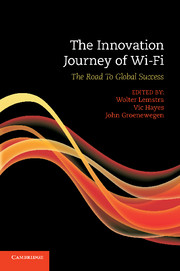Book contents
- Frontmatter
- Contents
- Figures
- Tables
- Contributors
- Preface
- Introduction
- 1 The case and the theoretical framework
- Part 1 The Wi-Fi Journey
- Part 2 The Wi-Fi Journey in Perspective
- 7 Wi-Fi in developing countries: catalyst for network extension and telecom reform
- 8 The Dutch connection to US-based NCR, AT&T, Lucent Technologies and Agere Systems
- 9 Wi-Fi as community-based innovation
- 10 The governance of radio spectrum: licence-exempt devices
- 11 Exploring the future of Wi-Fi
- 12 Reflections and implications for policy and strategy formation
- Part 3 Annexes
- Index
- References
9 - Wi-Fi as community-based innovation
Published online by Cambridge University Press: 05 June 2012
- Frontmatter
- Contents
- Figures
- Tables
- Contributors
- Preface
- Introduction
- 1 The case and the theoretical framework
- Part 1 The Wi-Fi Journey
- Part 2 The Wi-Fi Journey in Perspective
- 7 Wi-Fi in developing countries: catalyst for network extension and telecom reform
- 8 The Dutch connection to US-based NCR, AT&T, Lucent Technologies and Agere Systems
- 9 Wi-Fi as community-based innovation
- 10 The governance of radio spectrum: licence-exempt devices
- 11 Exploring the future of Wi-Fi
- 12 Reflections and implications for policy and strategy formation
- Part 3 Annexes
- Index
- References
Summary
Introduction
In this third chapter on the broader perspectives of the Wi-Fi innovation journey, the role of the user in community-based innovation is studied in detail.
The domain of information and communication technologies has become one in which the boundaries between producers and users have become increasingly fuzzy. The availability of free and open source software is a clear example of how communities of computer users develop many varieties of software. In a similar vein, many popular web services build on the efforts of – often experienced and skilful – users. Examples include the many blogs, podcasts and videocasts; customer-written product reviews on Amazon; and the free encyclopaedia Wikipedia. Time magazine even put ‘You’ (the internet user) on its cover as Person of the Year 2006. At the physical layer of telecommunication infrastructures, however, user-initiated products and innovations are quite rare. This level is dominated by commercial telecom and cable operators, which finance, produce, install, maintain and innovate the expensive and often large-scale ICT infrastructures. Free access to radio frequency spectrum, originally intended for indoor use with Wi-Fi as a successful implementation of wireless local area networking, has inspired users to develop local wireless infrastructures themselves, however, challenging this organisational dominance.
- Type
- Chapter
- Information
- The Innovation Journey of Wi-FiThe Road to Global Success, pp. 263 - 287Publisher: Cambridge University PressPrint publication year: 2010
References
- 1
- Cited by

